Monday Oct. 2, 2006
Optional Assignment #2 was collected in class today.
Optional Assignment #3 questions will be asked
during class on Monday, Wednesday, and Friday this week. This
assignment will be due at the beginning of class next Monday (Oct. 9).
The Experiment #2 reports and the Expt. #1 report revisions are also
due next Monday (Oct. 9). Return your Expt. #2 materials this
week so that you can pick up the supplementary information sheet.
All of the 1S1P Assignment #1
papers have now been graded.
Have a quick look at the classnotes from last
Friday's class. A few things were slipped in after
class. In particular note how the high specific heat of water
compared to soil will moderate the climate for a city located along a
coastline. Along a coast the winters would be as cold and the
summers won't be as hot as in a city that is further inland.

Convection is a second way of transporting energy.
Convection
involves more organized motion of atoms or molecules in a liquid or gas
(but not in a solid, the atoms or molecules aren't able to move freely
enough).
In the top picture above the air surrounding a hot object has been
heated by conduction. Then a person (yes that is a drawing of a
person's head) is blowing the blob of warm air
off to the right. Cooler air moves in and surrounds the hot
object and the cycle can repeat itself. This is forced
convection. If you have a hot object in your hand you could just
hold onto it and let it cool by conduction. That might take a
while because air is a poor conductor. Or you could blow on the
hot object and force it to cool more quickly.
Note, in the bottom left figure, that the hot air is also low density
air. It actually isn't necessary to blow on the hot object, the
warm air will rise by itself. Energy is being transported away
from the hot object. This is called free convection and
represents another way of causing rising air motions in the atmosphere
(rising air motions are important because rising air expands (as it
moves into lower pressure surroundings) and cools. If the air is
moist, clouds can form.
Note the example at right is also free convection. The sinking
air motions that would be found around a cold object have the effect of
transporting energy from the warm surroundings to the colder object.
Now some
"real life" applications of energy transport by conduction and
convection.

Metals are better conductors than wood. If you touch a
piece of
70 F metal it will feel colder than a piece of 70 F wood. A piece
of 70 F diamond would feel even colder because it is a better conductor
than metal. Our perception of cold is more an indication of how
quickly our hand is losing energy than a reliable measurement of
temperature.
Touching a piece of ice also feels colder even though ice is not an
especially good conductor. The cold feeling tells us that our
hand is losing a lot of energy. I this case the high rate of
energy loss is due to the large temperature differrence between our
hand and the ice rather than just the thermal conductivity of the ice.
If you go outside on a 40 F day (calm winds) you will feel cold; your
body is losing energy to the colder surroundings. A thermometer
behaves differently. It actually cools to the temperature of the
surroundings. Once there it won't lose any additional energy.
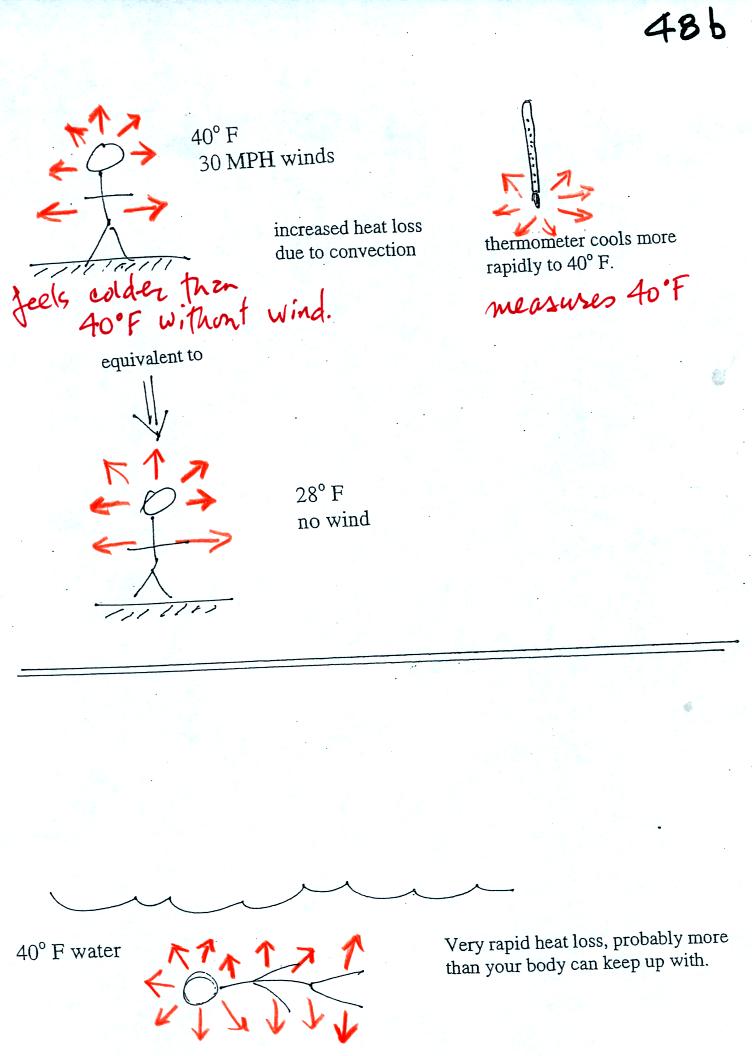
If you go outside on a 40 F day with 30 MPH winds your body
will lose
energy at a more rapid rate. It will feel colder than a 40 F day
with calm winds. Actually, in terms of the rate at which your
body loses energy, the windy 40 F day would feel the same as a calm 28
F day. The combination 40 F and 30 MPH winds results in a wind
chill temperature of 28 F. The thermometer will again cool to the
temperature of its surroundings. ON a windy day it will cool more
quickly, but once it ends up at 40 F it won't cool any further. The
thermometer would measure 40 F on both the calm and the windy day.
Water is a much better conductor than air. If you fall into 40 F
water your body will lose energy at a high enough rate that your
metabolism might not be able to keep up with it. Falling into 40
F water is a life-threatening situation.
Energy
transport in the form of latent heat is the second most important
energy transport process (second only to electromagnetic
radiation). It is a little tricky to see how the energy is
actually transported from one place to another. Before worrying
about that a little review is necessary.
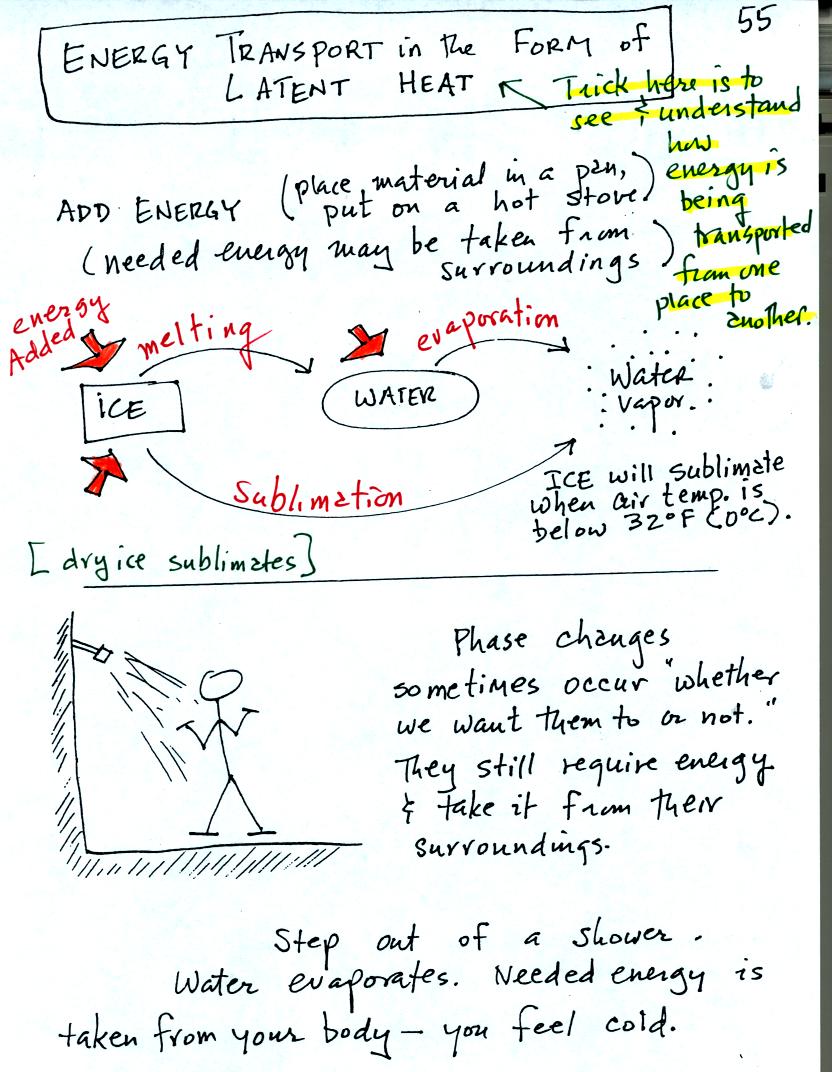
A solid to liquid phase change is melting, liquid to gas is
evaporation, and sublimation is a solid to gas phase change (dry ice
sublimates when placed in a warm room, it turns directly from solid
carbon dioxide to gaseous carbon dioxide).
In
each case energy must be added to the material changing phase.
You can consciously supply the energy (such as when you put water in a
pan and put the pan on a hot stove) or the needed energy will be
taken from the surroundings (from your body when you step out of a
shower in the morning).
Here's a school kids analogy:

You need to give a kid some energy in order to get him or her up and
walking around. Even more energy is needed to get the kid outside
running.
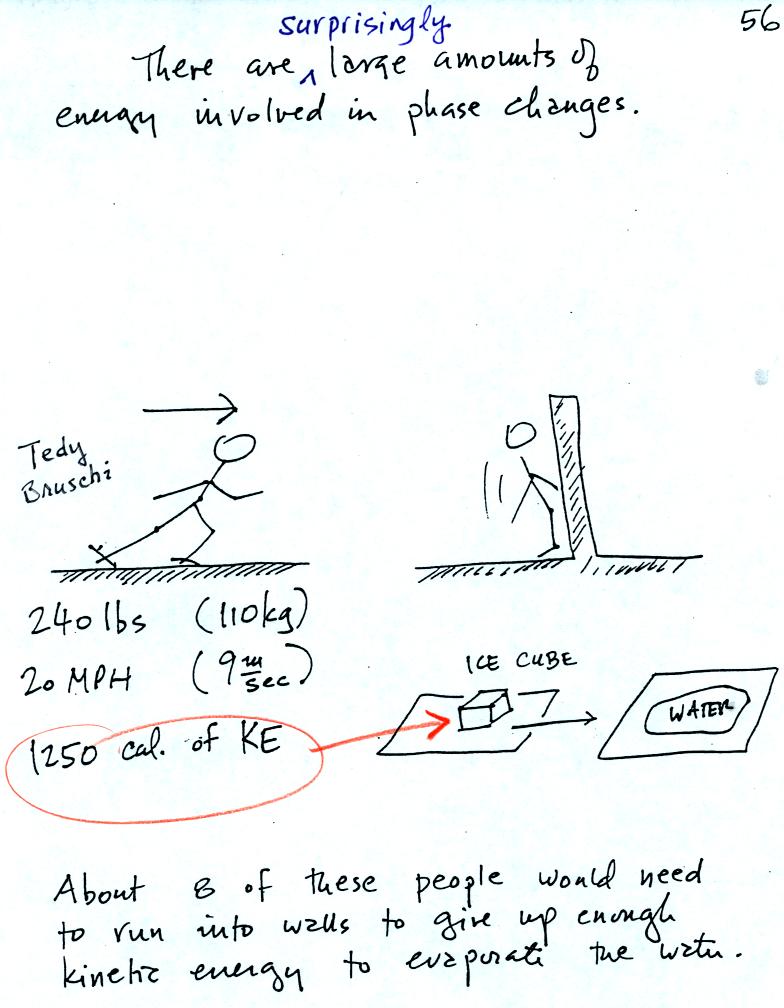
A 240 pound man (or woman) running at 20 MPH has just enough
energy to
be able to melt an ordinary ice cube. It would take 8 people to
evaporate the resulting water.

You can consciously remove energy from water vapor to make it condense
or from water to cause it to free (you could put water in a freeze, a
cold "box"; energy would flow from the relatively warm water to the
colder surroundings). Or if one of these phase
changes occurs energy will be released into the surroundings (causing
the surroundings to warm).
A can of cold drink will warm more quickly in warm moist surroundings
than in warm dry surroundings. Heat will flow from the warm air
into the cold cans in both cases. Condensation of water vapor is
an additional source of energy and will warm that can more rapidly.
Here are the school kids again. They're out on the play ground
running around and you need to get them back inside the classroom and
sitting at their desks.

Now we put everything together and see how energy gets carried
from one place to another.
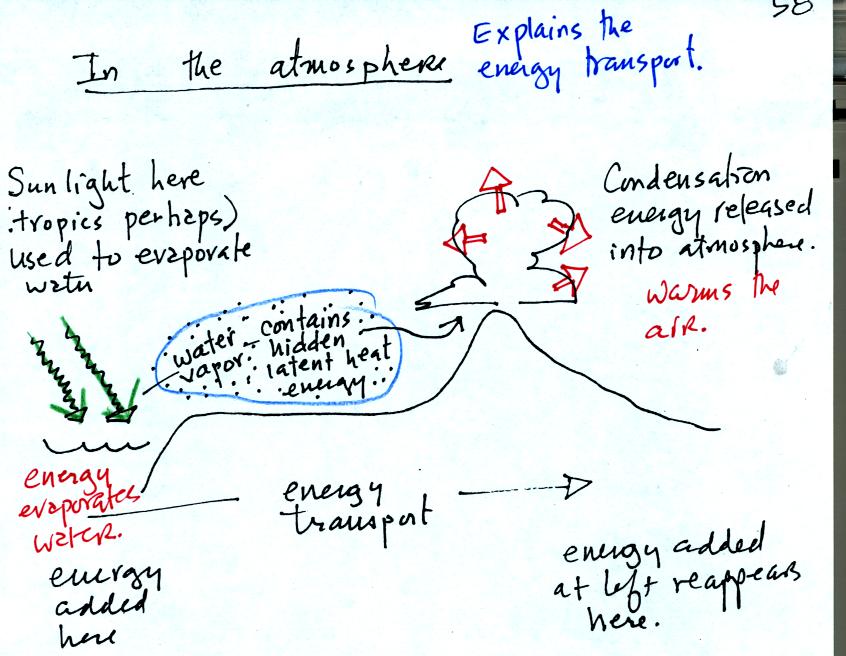
The story starts at left in the
tropics where there is often an abundance or surplus of energy;
sunlight
evaporates ocean water. The resulting water vapor moves somewhere
else and carries hidden latent heat energy. This hidden energy
reappears when something (air running into a mountain and rising,
expanding, and cooling) causes the water vapor to condense. The
condensation releases energy into the surrounding atmosphere.
Energy arriving in sunlight in the tropics has effectively been
transported to the atmosphere in Tucson.
We'll
spend the next two or three class periods on electromagnetic
radiation. It is the most important energy transport process
because it can travel through empty space.
To really understand EM radiation you need to understand electric
fields. To understand electric fields we need to quickly review
static electricity.

We used a sweater and two balloons to demonstrate the rules above.
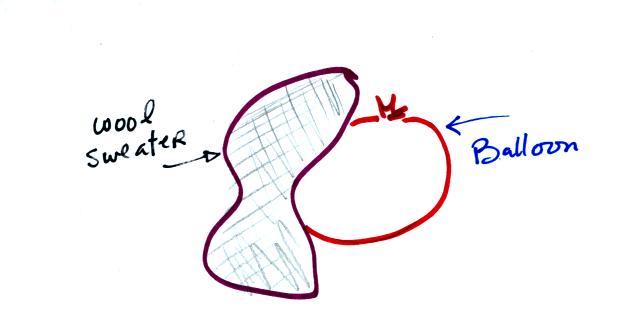
If you rub a balloon with a wool sweather the balloon and the sweater
become electrically charged (static electricity is one of the reasons I
don't like wearing wool sweaters).
We actually charged up two balloons. We didn't know what charge
the balloons carried just that they both had the same charge.

If you bring the balloons close to each other they are pushed apart by
a repulsive electrical force.
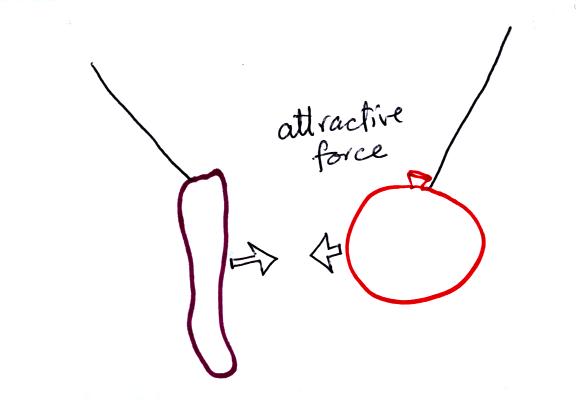
The sweater and the balloon carry opposite charges. IF they are
brought together they experience an attractive electrical force.
Now the bottom figure from p. 59 in the photocopied class notes which wasn't shown in class on Monday.

The balloons can help you understand
the picture above. Imagine placing one of the balloons at the
center of the picture and assume that it is positively charged.
The second balloon is placed at various positions (1, 2, and 3) around
the central balloon. The arrows in the picture are the electric
field. They give the direction and strength of the force that
would be exerted on the second positive charge. At Position 1,
for example a positively charged balloon would be pushed (by the +
charge on the center balloon) to the upper right with a strong
force. At Position 2 the force points straight up but isn't as
strong because the + charge at Position 2 is further from the center
charge. At Position 3 the charge is pushed to the left with a
weak force.
You can also use the electric field arrows to figure out what would
happen to a negative charge. The direction of the force is
reversed.
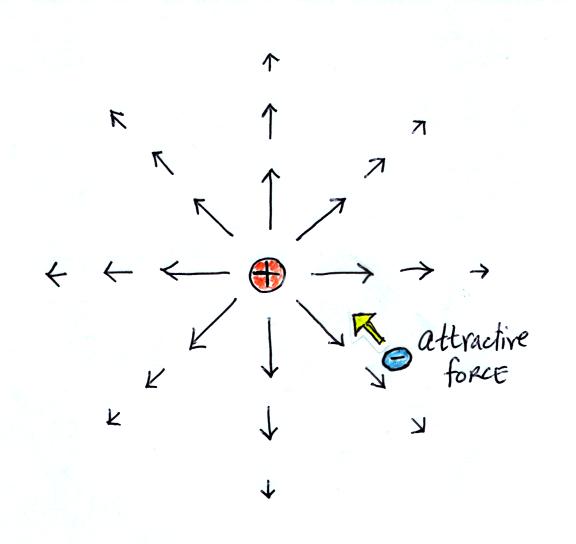
The negative charge is attracted by the positive charge in the center
of the picture. Here are some sample questions
about static electricity and electric fields (these are not part of Optional
Assignment #3).














